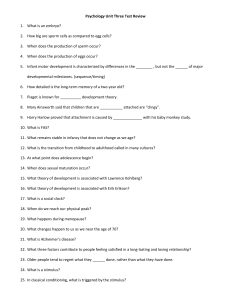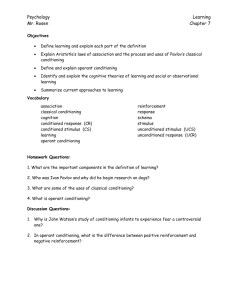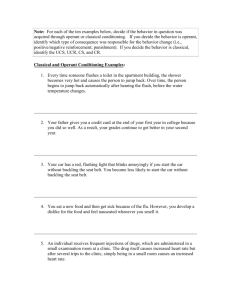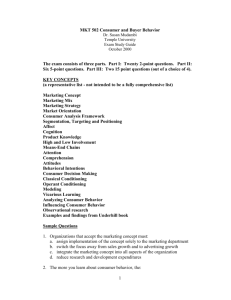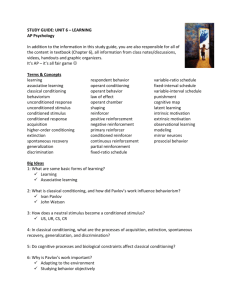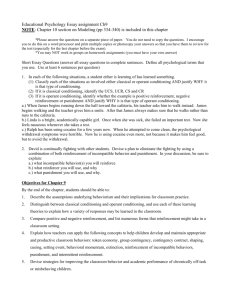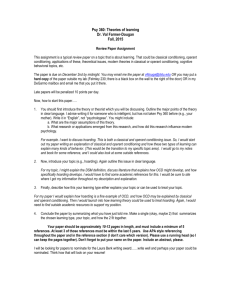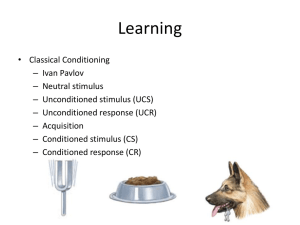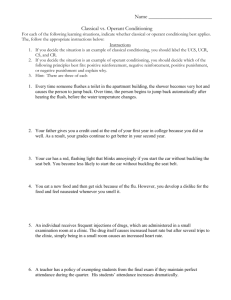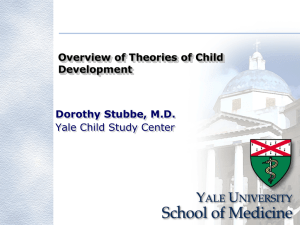Learning Schedule and Study Guide
advertisement
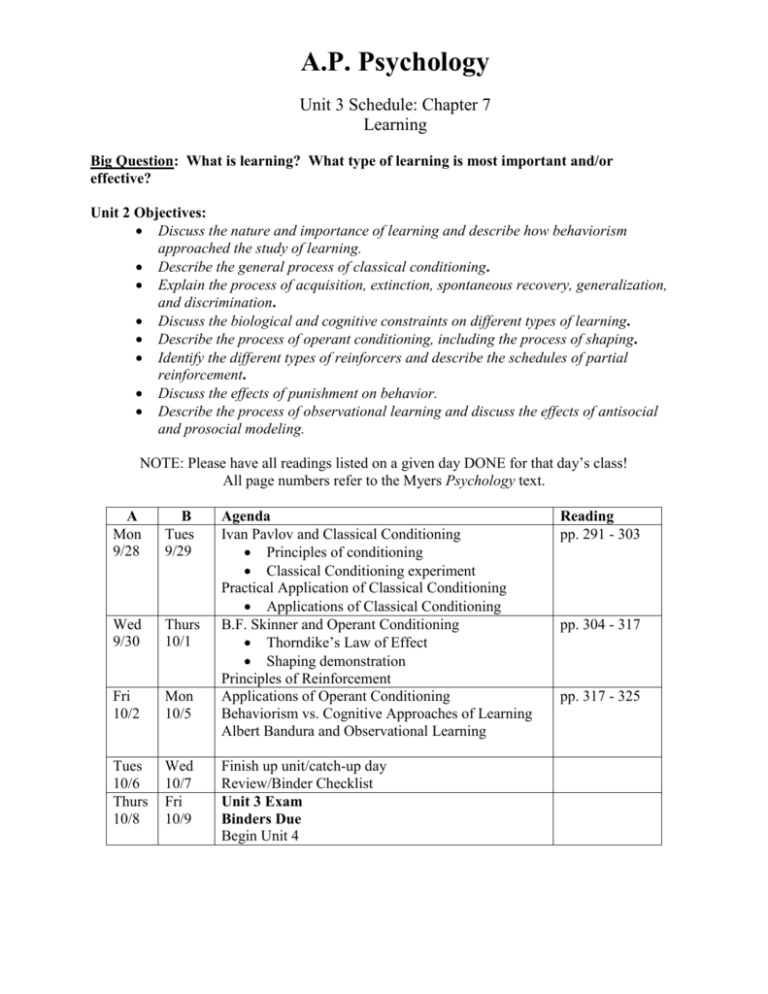
A.P. Psychology Unit 3 Schedule: Chapter 7 Learning Big Question: What is learning? What type of learning is most important and/or effective? Unit 2 Objectives: Discuss the nature and importance of learning and describe how behaviorism approached the study of learning. Describe the general process of classical conditioning. Explain the process of acquisition, extinction, spontaneous recovery, generalization, and discrimination. Discuss the biological and cognitive constraints on different types of learning. Describe the process of operant conditioning, including the process of shaping. Identify the different types of reinforcers and describe the schedules of partial reinforcement. Discuss the effects of punishment on behavior. Describe the process of observational learning and discuss the effects of antisocial and prosocial modeling. NOTE: Please have all readings listed on a given day DONE for that day’s class! All page numbers refer to the Myers Psychology text. A Mon 9/28 B Tues 9/29 Wed 9/30 Thurs 10/1 Fri 10/2 Mon 10/5 Tues 10/6 Thurs 10/8 Wed 10/7 Fri 10/9 Agenda Ivan Pavlov and Classical Conditioning Principles of conditioning Classical Conditioning experiment Practical Application of Classical Conditioning Applications of Classical Conditioning B.F. Skinner and Operant Conditioning Thorndike’s Law of Effect Shaping demonstration Principles of Reinforcement Applications of Operant Conditioning Behaviorism vs. Cognitive Approaches of Learning Albert Bandura and Observational Learning Finish up unit/catch-up day Review/Binder Checklist Unit 3 Exam Binders Due Begin Unit 4 Reading pp. 291 - 303 pp. 304 - 317 pp. 317 - 325 Chapter 7 Overview “No topic is closer to the heart of psychology than learning, a relatively permanent change in an organism’s behavior due to experience.” Chapter 7 covers the basic principles of three forms of learning: classical, or respondent conditioning, in which we learn associations between events; operant conditioning, in which we learn to engage in behaviors that are rewarded and to avoid behaviors that are punished; and observational learning, in which we learn by observing and imitating others. The chapter also covers several important issues, including the generality of principles of learning, the role of cognitive process in learning, and the ways in which learning is constrained by the biological predispositions of different species. Key Terms Using your own words, write a brief definition or explanation of each of the following. Do this after or while reading the assigned pages for class. 1. learning – 2. associative learning – 3. behaviorism – 4. classical conditioning – 5. unconditioned response (UCR) – 6. unconditioned stimulus (UCS) – 7. conditioned response (CR) – 8. conditioned stimulus (CS) – 9. acquisition – 10. extinction – 11. spontaneous recovery – 12. generalization – 13. discrimination – 14. operant conditioning – 15. operant behavior – 16. law of effect – 17. Skinner box (operant chamber) – 18. shaping – 19. reinforcer – 20. primary reinforcers – 21. secondary reinforcers – 22. continuous reinforcement – 23. partial reinforcement – 24. punishment – 25. cognitive map – 26. latent learning – 27. overjustification effect – 28. observational learning – 29. modeling – 30. mirror neurons – 31. prosocial behavior – Learning Chapter Study Guide Complete the following study guide as you read the assigned pages for class. Classical Conditioning (pp. 291-303) 1. Describe the nature of classical conditioning and show how it demonstrates associative learning. Use an example in your answer. 2. Explain the processes of acquisition, extinction, spontaneous recovery, generalization, and discrimination. Give an example of each. 3. Show – using diagrams like those used in class – how Garcia’s taste aversion studies show classical conditioning. 4. Discuss the important of Pavlov’s work in classical conditioning and explain how Pavlov paved the way for the behaviorist position. Operant Conditioning (pp. 304-317) 5. Briefly describe the process of operant conditioning, including the procedure of shaping. Then, explain in steps how a psychologist might train a rat to play basketball (put a ball in a cup). 6. Identify the different types of reinforcers and describe the four major schedules of partial reinforcement. Give at least one example for each schedule. 7. Explain how punishment can have at least four types of unintended side effects. Based on this, if you were a parent, would you use spanking as a punishment? Support your answer. 8. Explain how reinforcement can affect intrinsic motivation. Give an example in your answer. 9. Explain how biological predispositions would affect an animal trainer. Learning by Observation (p. 317-325) 10. Describe the process of observational learning. Include an explanation of prosocial vs. antisocial behavior modeling. General 11. Find and attach 3 cartoons (excluding those in the textbook) illustrating a concept from this unit. Include an explanation of the cartoon using psychological language and concepts.
